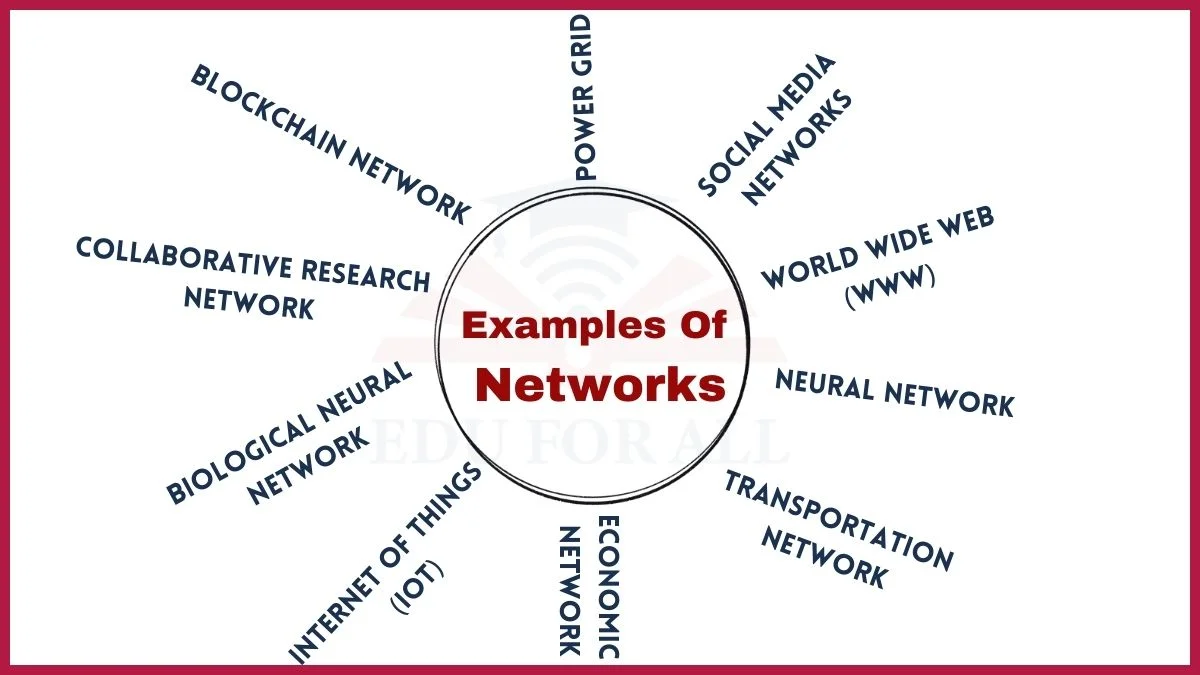A network is an interconnected system of things or people that facilitates the transfer of information, goods, services, or other resources.
Examples of networks include social media networks, the World Wide Web, neural networks, transportation networks, biological neural networks, economic networks, and more.
Examples Of Networks
Here are the best examples of networks:

1. Social Media Networks
Social media networks like Facebook, Twitter, and Instagram connect individuals globally, facilitating the exchange of information, ideas, and multimedia content. With billions of users, these platforms create a vast web of interconnected relationships, forming a dynamic virtual society.
As of 2022, Facebook has over 2.8 billion monthly active users, illustrating the extensive reach of social media networks.
2. World Wide Web (WWW)
The World Wide Web is a complex interlinked system of web pages and websites accessed through the Internet. It enables the seamless sharing of information, making it a classic example of a network that connects individuals, businesses, and organizations worldwide.
Over 4.9 billion web pages are indexed on the internet, showcasing the vastness of the interconnected information available on the World Wide Web.
3. Neural Network
Neural networks are inspired by the human brain. It consists of interconnected nodes that process and transmit information. Used in machine learning, these networks excel at pattern recognition and decision-making. Making them fundamental in applications like image and speech recognition.
Deep learning neural networks, with multiple layers of interconnected nodes, have achieved remarkable success, outperforming traditional algorithms in various complex tasks.
4. Transportation Network
A transportation network encompasses roads, railways, air routes, and maritime channels. These interconnected systems facilitate the movement of people, goods, and services, contributing to economic development and global connectivity.
The global air transportation network handles over 4 billion passengers annually, highlighting the extensive interconnectivity of air travel.
5. Internet of Things (IoT)
The Internet of Things connects everyday devices and objects to the Internet. It enables them to share data and communicate with each other. This network enhances efficiency and automation in various domains, from smart homes to industrial processes.
It is estimated that by 2030, there will be over 25 billion connected IoT devices worldwide, revolutionizing how we interact with technology.
6. Biological Neural Network
The human brain is a complex biological neural network composed of interconnected neurons. These neurons transmit electrical signals, forming the basis of cognition, perception, and various bodily functions, showcasing the difficulty of biological networks.
The human brain contains around 86 billion neurons, each forming thousands of connections, emphasizing the immense complexity of biological neural networks.
7. Economic Network
Economic networks involve the interconnected relationships among businesses, financial institutions, and consumers. Stock markets, supply chains, and trade routes form a global economic network that influences the prosperity of nations and the livelihoods of individuals.
The global economy is estimated to be worth over $87 trillion, emphasizing the vast scale of interconnected economic activities.
8. Power Grid
Power grids are networks that transmit and distribute electricity from power plants to homes and businesses. The interconnected nature of the grid ensures a reliable supply of electricity, supporting the functioning of modern societies.
The U.S. power grid comprises over 450,000 miles of high-voltage transmission lines, illustrating the extensive infrastructure of the electrical network.
9. Collaborative Research Network
Scientific and academic communities rely on collaborative research networks to share knowledge, resources, and expertise. These networks foster innovation, enabling researchers worldwide to collaborate on projects and advancements.
ResearchGate, a platform connecting researchers, boasts over 20 million members and provides a space for sharing academic publications and collaboration.
10. Blockchain Network
Blockchain is a separate and distributed ledger technology that forms the basis of cryptocurrencies like Bitcoin. The network consists of nodes that validate and record transactions, ensuring transparency, security, and immutability.
The Bitcoin blockchain processes an average of 300,000 transactions daily, highlighting the scalability and resilience of blockchain networks in handling digital transactions.

